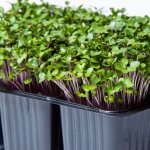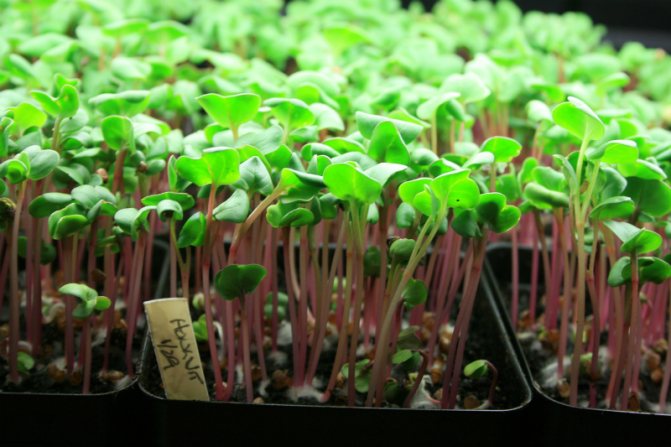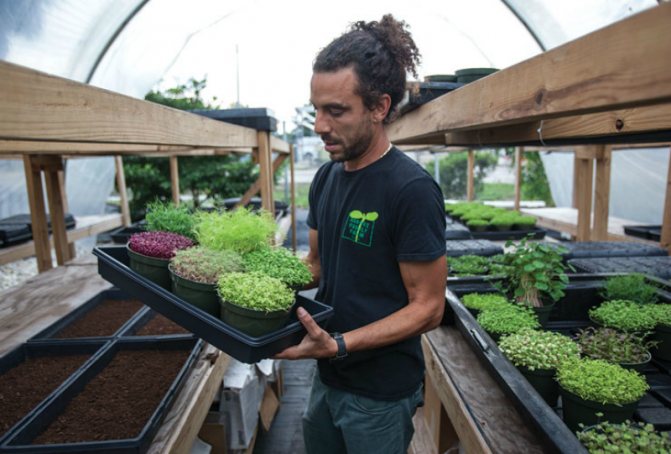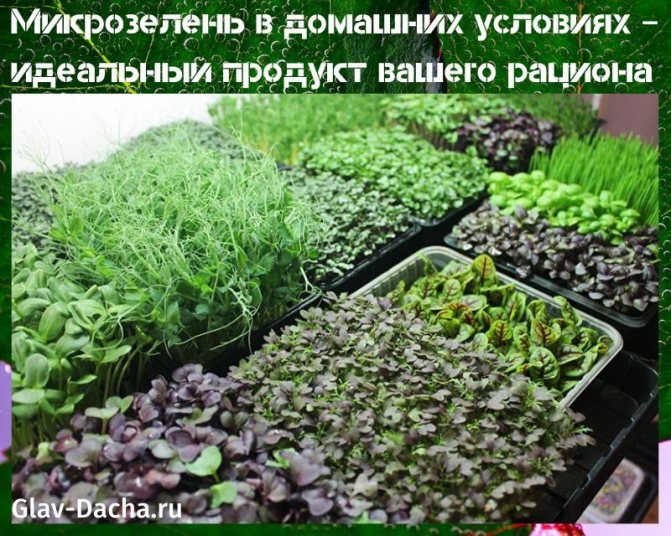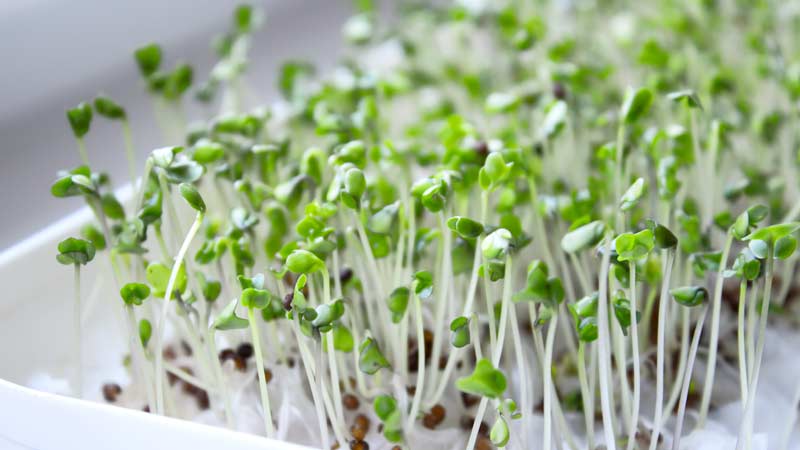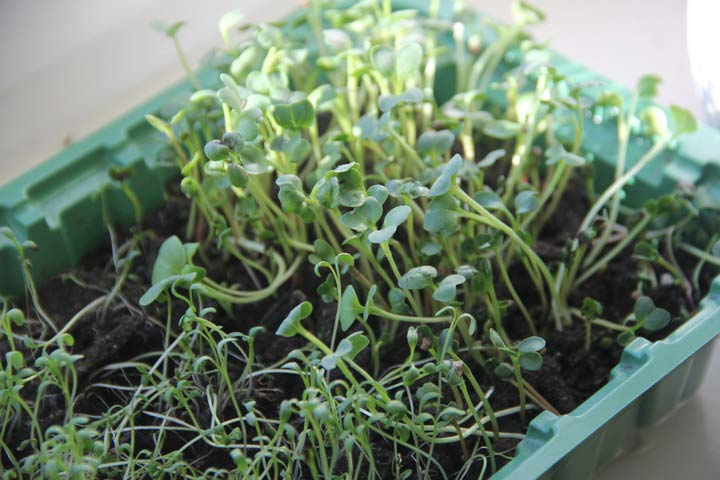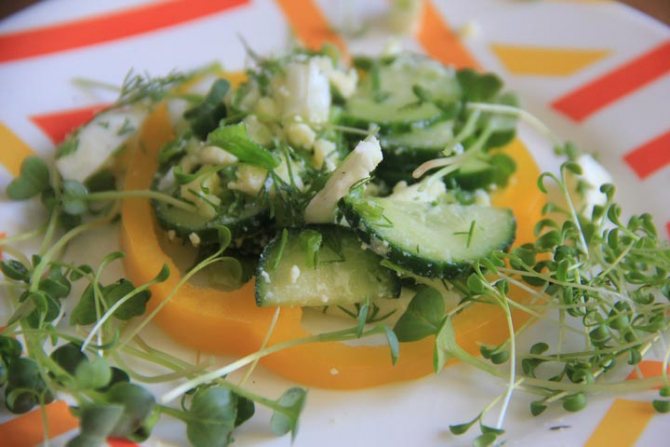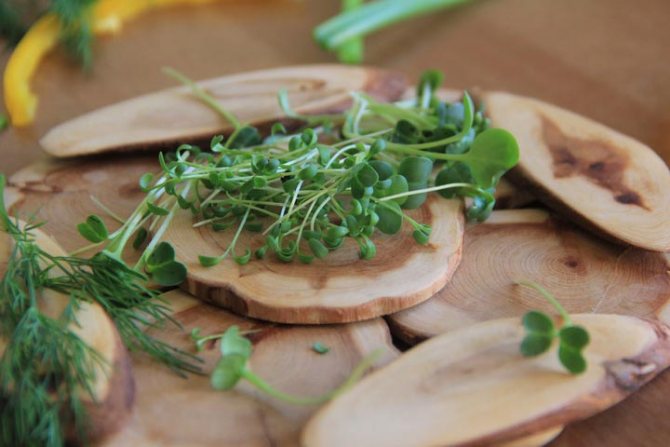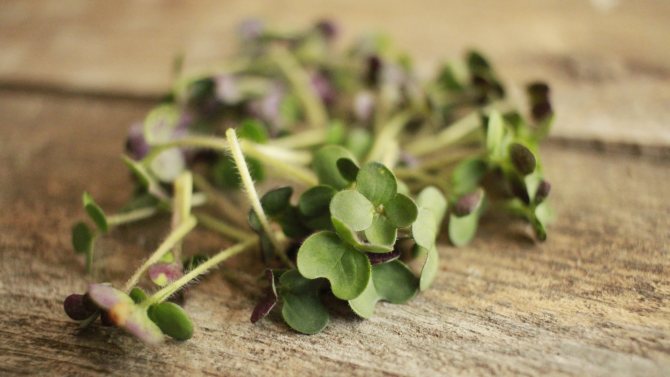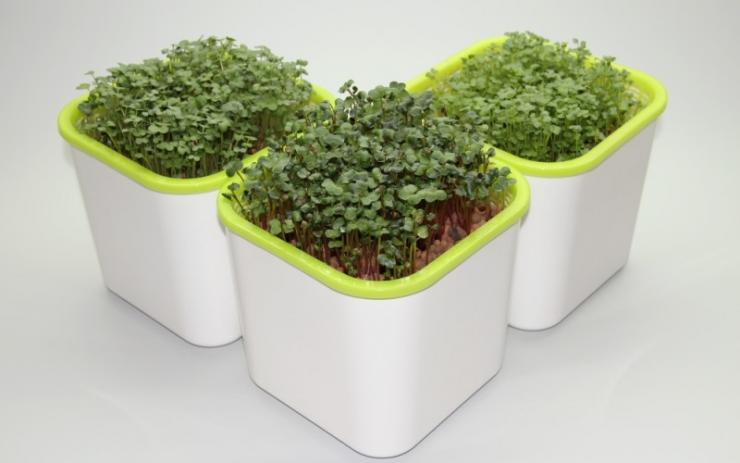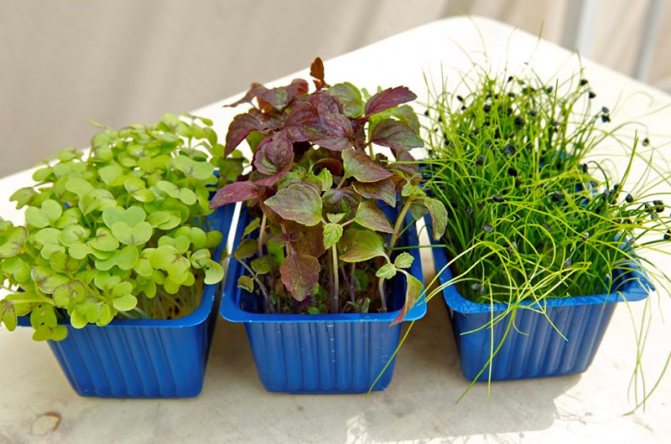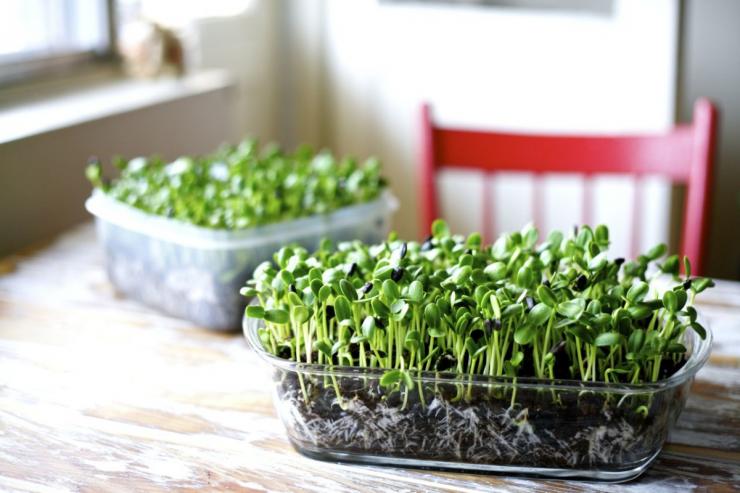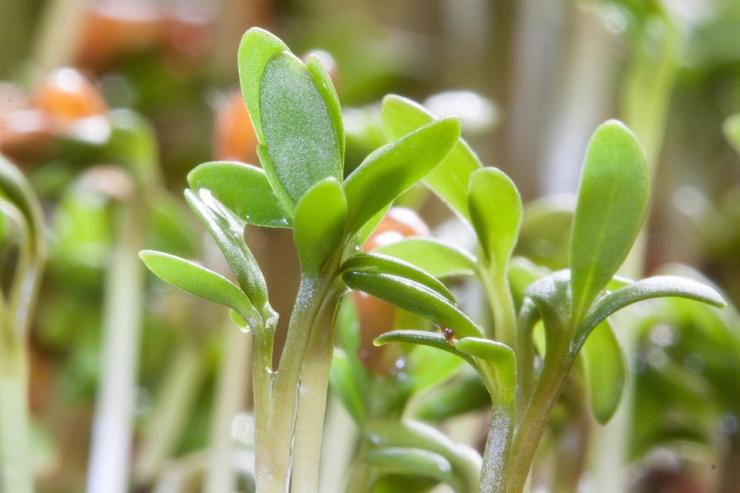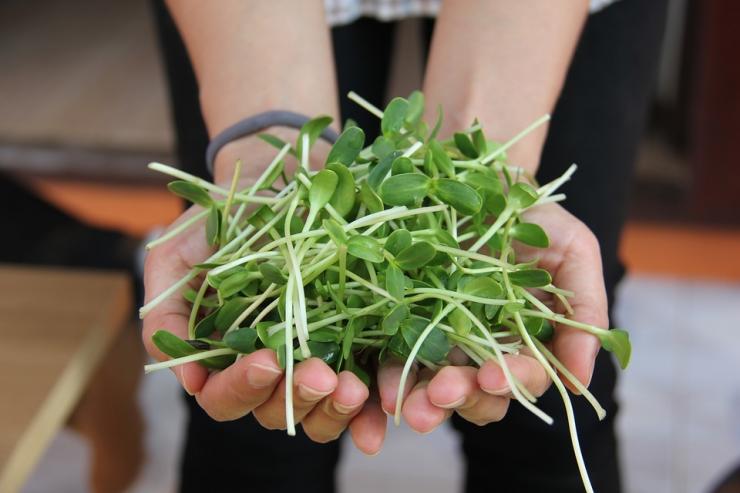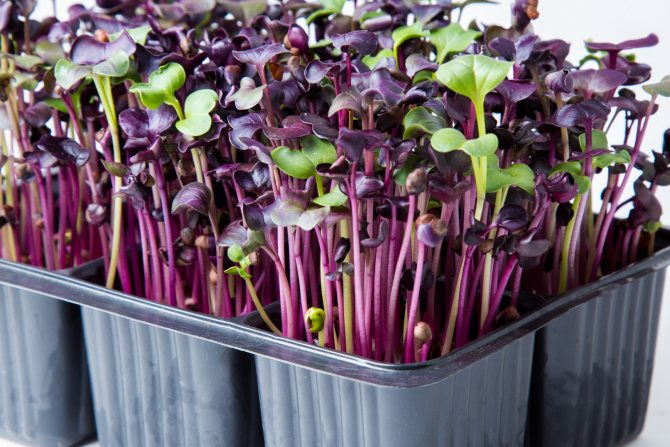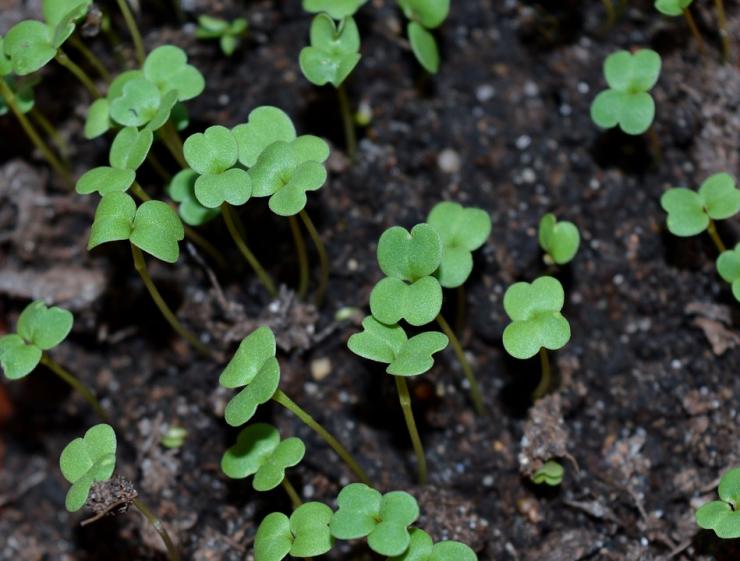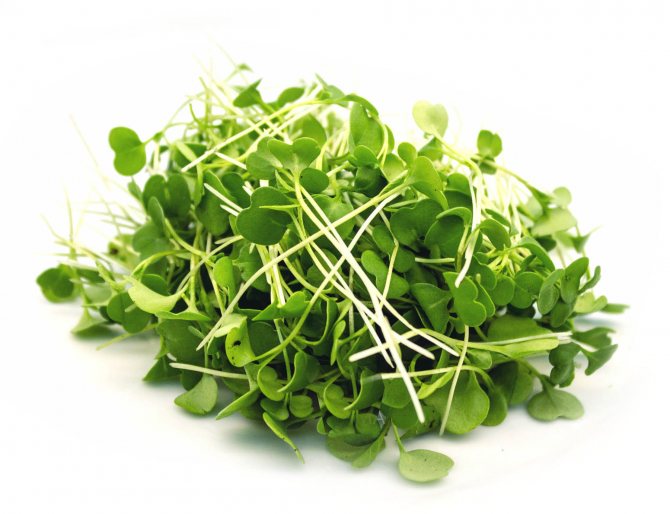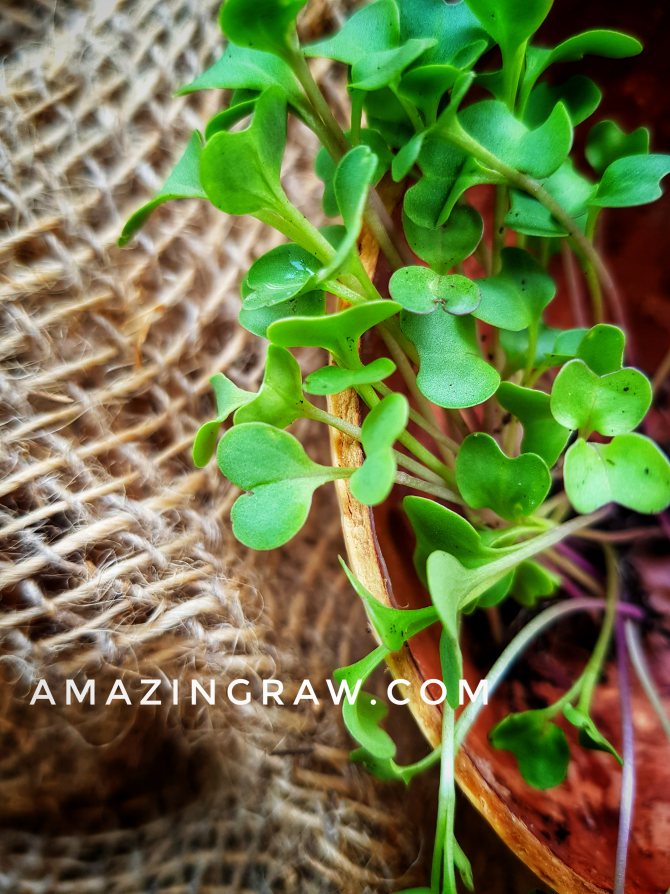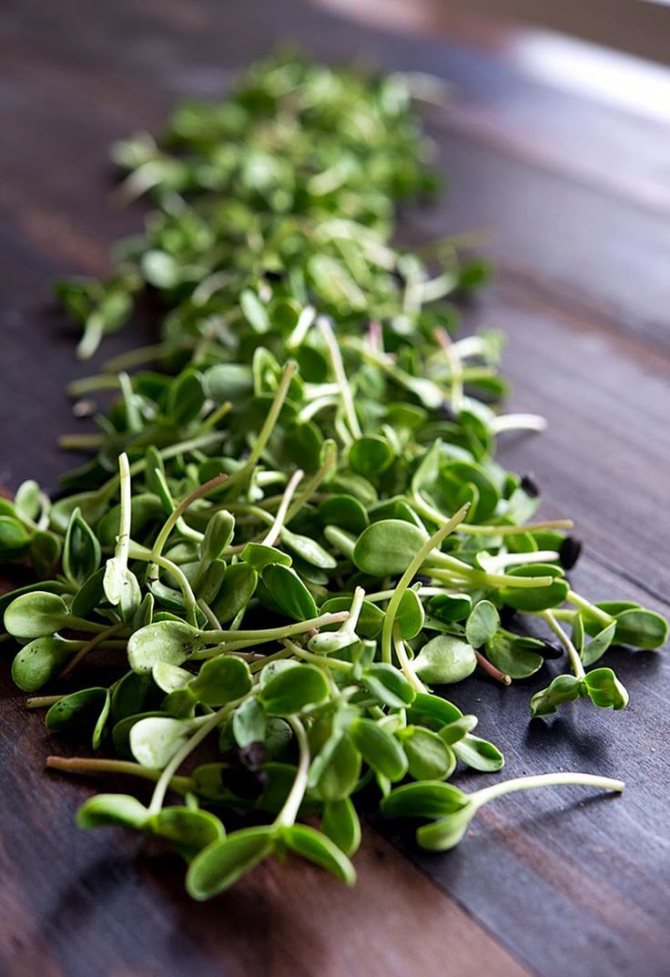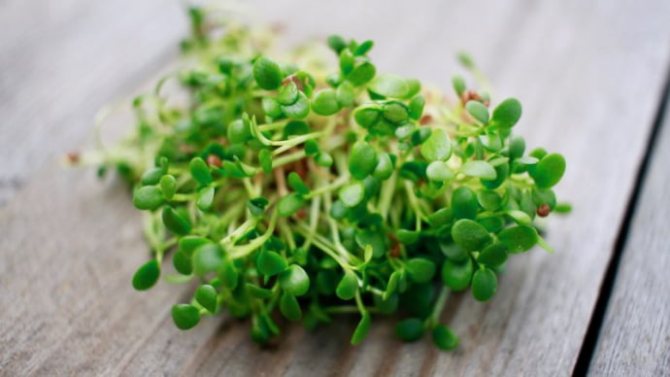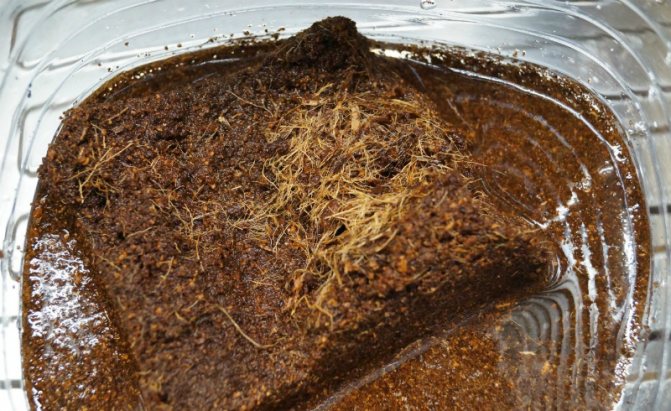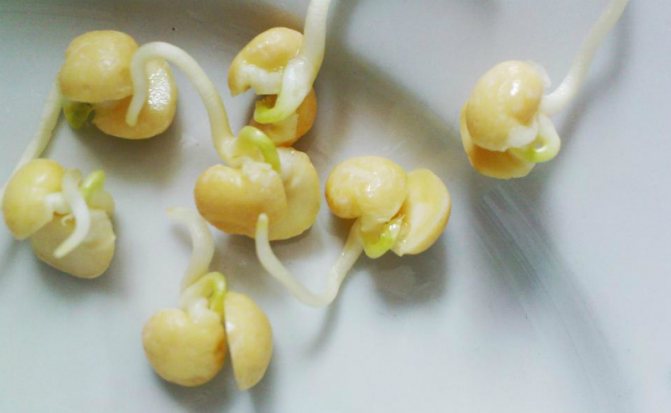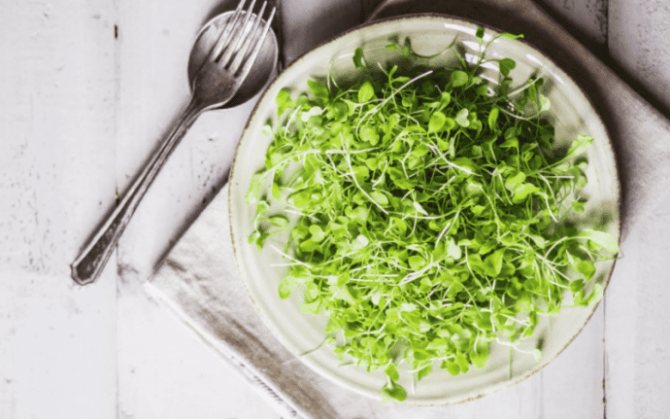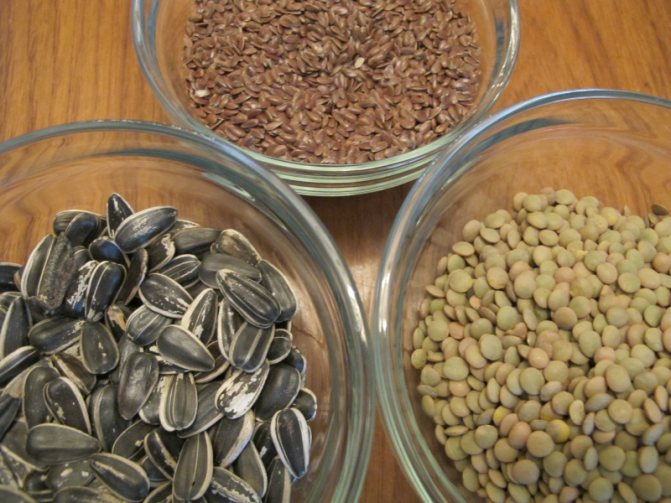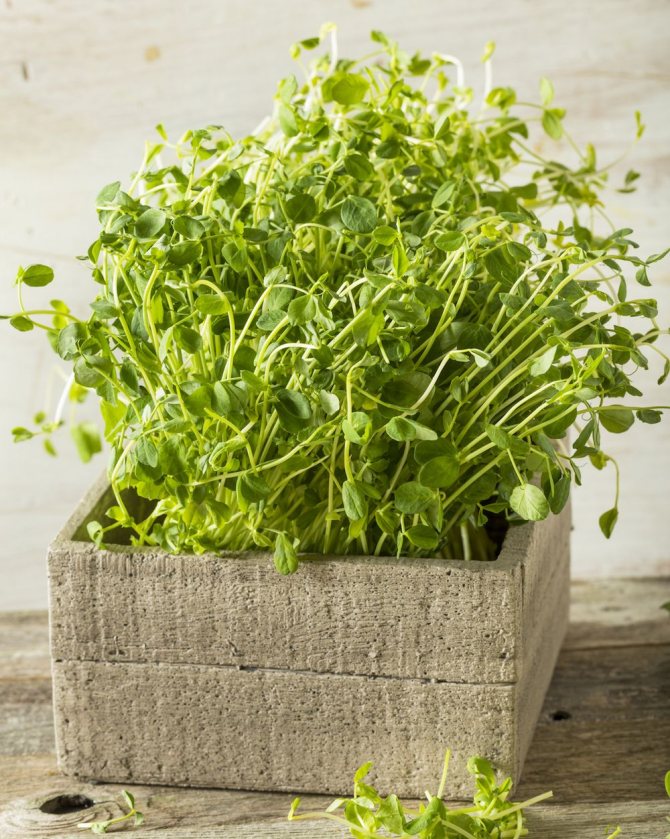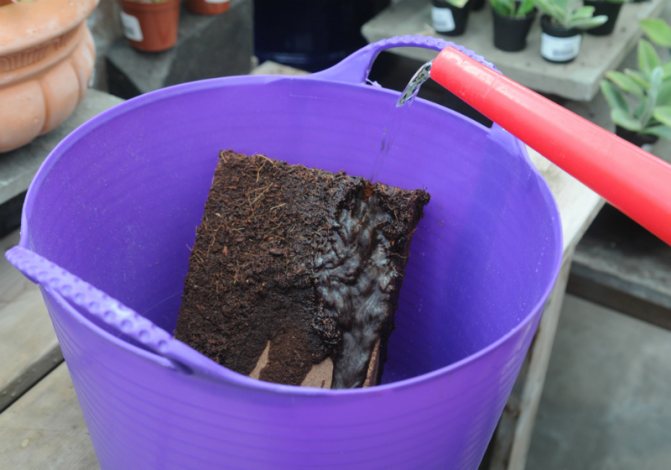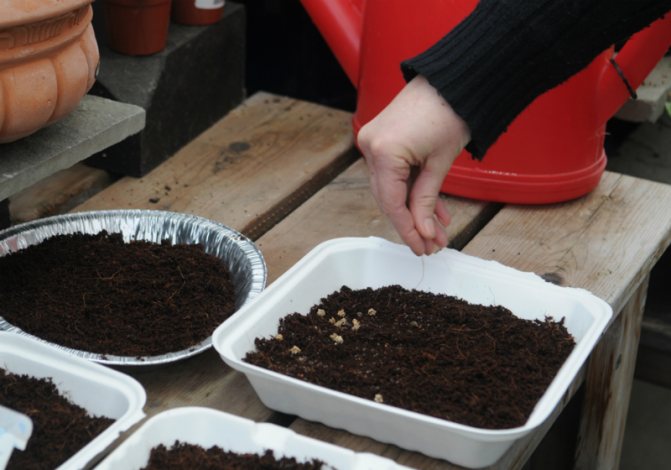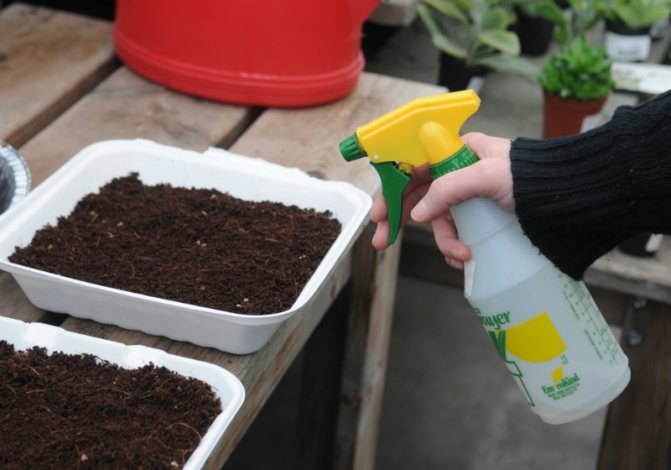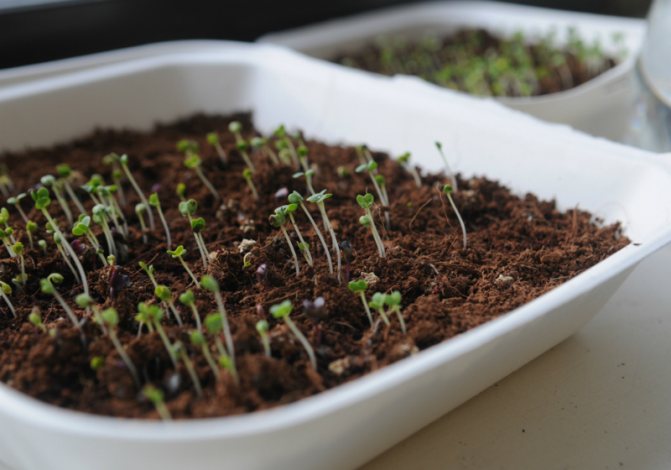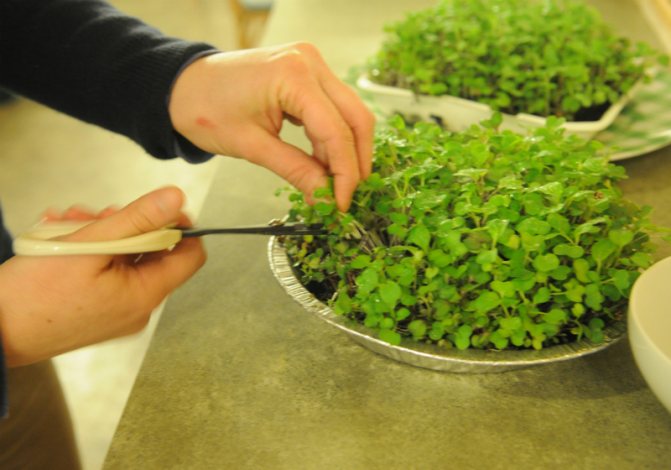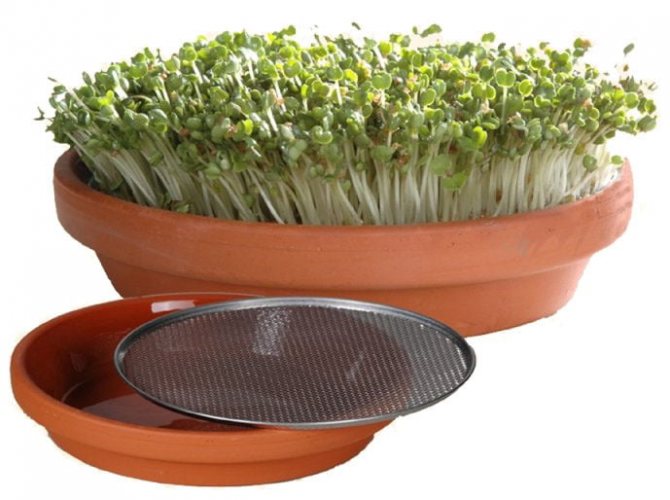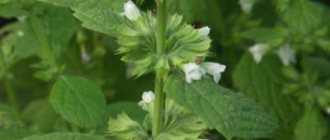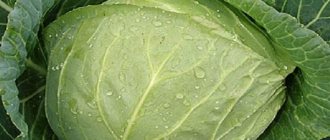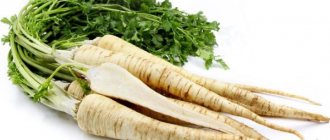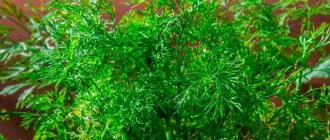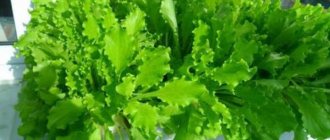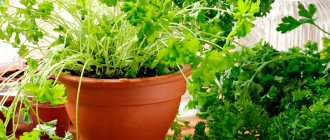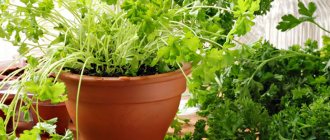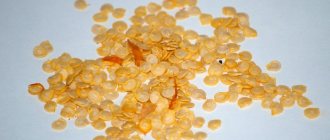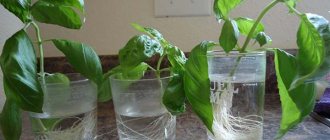In previous articles, I have already told you what is the use of microgreens and how to grow it with soil (active links will be at the end). But in winter you can't dig up land from your garden, and good soil is not always available for sale. What to do? You can grow microgreens at home and without land. How exactly - read on.
Description and features
San Francisco is considered the birthplace of the systematic cultivation of microgreens. In the 1980s, restaurants in this city began to decorate dishes with green twigs with a couple of leaves. Gourmets appreciated it. Microgreens began to be used in California, then moved to Europe. Its spread coincided with the popularization of a healthy lifestyle.
Edible sprouts are obtained from the seeds of various types of vegetables and herbs. Microgreens are stalks with cotyledons and, sometimes, the first pair of leaflets, which can be partially or fully developed.
When harvesting, the stems of the plants are cut in the immediate vicinity of the soil. The height of the surface part of plants is from 2.0 to 7.5 cm - blades of grass of this length fall into the hands of cooks and go to prepare dishes.
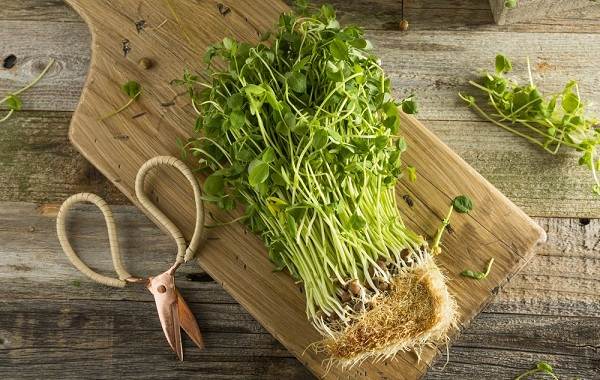
Microgreens are thought to contain more benefits than grown plants.
What microgreens can be grown?
Well, here the flight of imagination is very, very wide)).
What can be grown?
- Greens - basil, watercress, amaranth, dill, chard, coriander / cilantro, arugula, lettuce, mustard, parsley, spinach and sorrel.
- Vegetables - beets, broccoli, cabbage, red cabbage, celery, carrots, radishes, daikon, radish, kohlrabi, fennel
- Cereals and legumes - oats, wheat, rice, lentils, barley, green buckwheat, peas, beans (although its microgreen looks more like a teenager than a kindergarden)).
- And flax and sunflower seeds - I just don't know where it is better to define them)). But they are also worth a separate place - incredibly tasty and juicy! (these are generally one of my favorites among microgreens)).
And the main thing, as well as in many respects, with regard to our nutrition is the variety! The maximum possible options are at your discretion, since each species has its own nutritional value, its own set of vitamins and nutrients.
Beneficial features
There are 10-40 times more useful substances in microgreens than in adult plants. Scientists from the University of Maryland (USA) have been monitoring the level of nutrients in microgreens for a long time. Each time, high levels of vitamin C, tocopherol (vitamin E), vitamin K, lutein and beta-carotene and others have been confirmed.
- Legumes: soybeans, lentils, corn, peas, mung bean, chickpeas. Rich in vegetable protein. In terms of its content, it is ahead of other plant species. Potassium and magnesium are present in the stems and leaves, which help the heart muscle to contract. Omega-3 and omega-6 are polyunsaturated acids, the benefits of which are constantly and everywhere talked about.
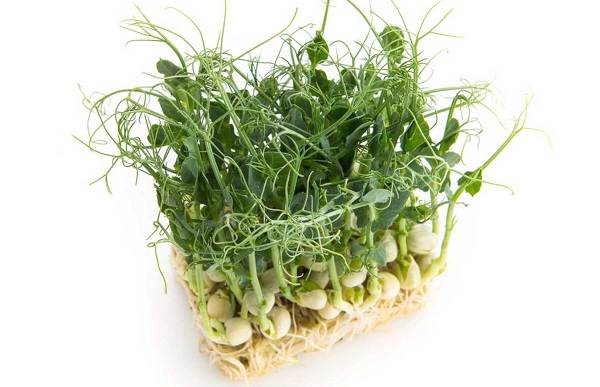

- Cereals: buckwheat, rice, oats, millet, sunflower, wheat, barley. The addition of microgreens grown from cereal seeds enriches food with beta-carotene, B vitamins, vitamin A, folic acid. In therapeutic doses, the sprouts contain metals: magnesium, sodium, potassium, manganese.
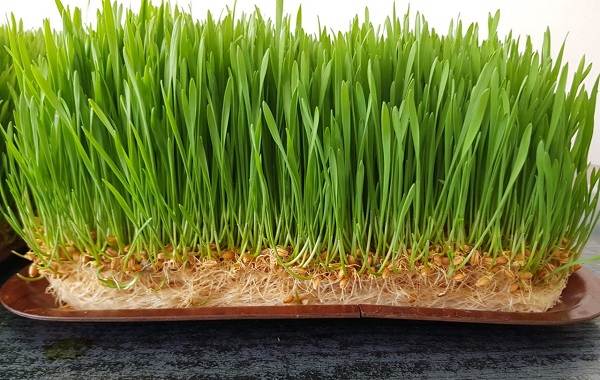

- Wild herbs: amaranth, clover, oxalis, nettle, quinoa, coriander, flax, alfalfa, nasturtium.The vitamin composition in many wild herbs is richer than in cultivated plants. The same applies to minerals.
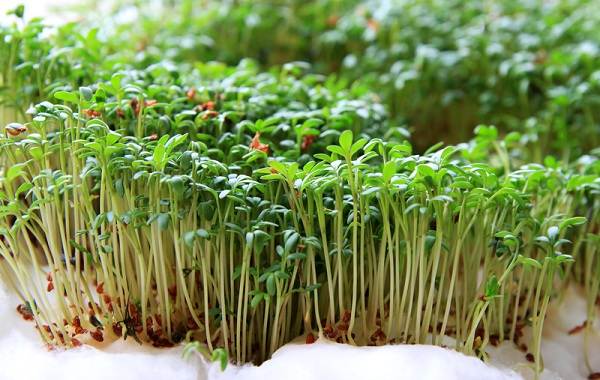

- Vegetable crops: cucumber, broccoli, zucchini, red cabbage, radishes, beets, garlic. The combination of vitamins, antioxidants, and other beneficial substances in vegetable microgreens makes each product unique.
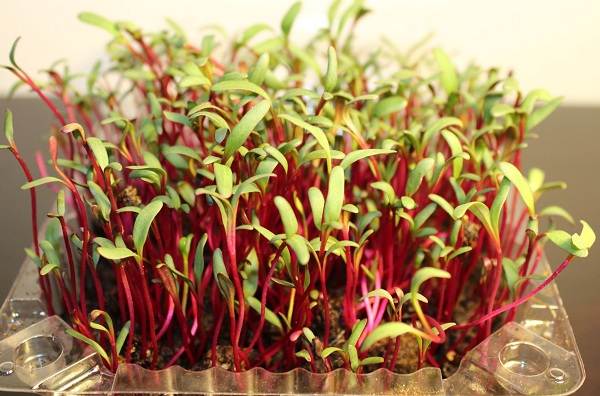

Almost any cultivated plant or grasses in the state of cotyledonous leaves are considered microgreens.
- Herbs and salads: basil, mustard, dill, cilantro, watercress, celery, arugula, spinach, sorrel, dill. Sprouts are not only beneficial, they are a pleasure: they brightly color the taste and smell of the final dish.
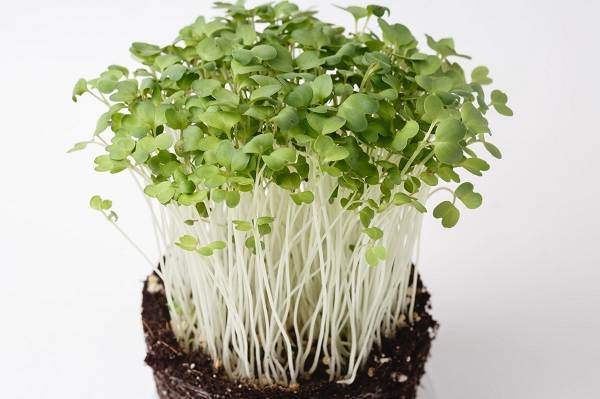

The concentrated content of nutrients, their unique combination allows the use of microgreens to strengthen the human immune system. This is not limited to the benefits of microgreens... The sprouts have a delicate aroma and complex taste. They are brightly colored, the leaves have an unusual shape. This is used by chefs when decorating dishes.
Microgreen has firmly established itself in the kitchens of the best restaurants, in the menu of connoisseurs of a healthy lifestyle and gourmets. Food lovers appreciate taste, smell, and appearance in young sprouts. Supporters of natural ways to strengthen the body, fight disease, use salads, cocktails from microgreens for health and healing purposes.
The benefits of microgreens
What substances, important for humans, does this microgreen contain in large quantities? According to numerous scientific studies, in young seedlings there was surprisingly a lot of vegetable protein, chlorophyll, vitamins (especially C, B, K, E), carotenoid pigments, mineral compounds (potassium, calcium, phosphorus, magnesium, iron, iodine, sulfur), essential oils.
Each of these substances helps our body in one way or another. So, folic acid is necessary for the processes of hematopoiesis and is simply irreplaceable in the nutrition of women of reproductive age. Tocopherol and ascorbic acid are excellent antioxidants. Carotenoids inhibit excessive cell division and have immunostimulating properties. Rutin helps prevent blood clots, reduces capillary permeability, and has anti-inflammatory activity. Sulforaphane has anti-cancer and antibacterial effects.
It makes no sense to even mention the benefits of numerous mineral compounds - it is obvious, because minerals take an active part in all processes of the human body. The use of microgreens with such a rich composition has a beneficial effect on the functioning of not only the digestive, but also the cardiovascular, hematopoietic, nervous, immune, excretory, reproductive, endocrine systems.
Garden, vegetable garden and flower garden tips
Planting corn seedlings in 2020 according to the lunar calendar
How to properly plant tomato seedlings in open ground
Floribunda roses outdoor planting and care for beginners
And chlorophyll has recently been actively studied as an extremely effective antitumor (anticancer) agent. And this is not to mention its long-proven properties as an antioxidant, as a compound that improves the transport of oxygen to the cells and tissues of the human body, increases immunity, helps to bind and remove toxins, inhibits the growth of pathogenic microflora, and reduces pain.
Remember, too, that each type of microgreen is valuable for its own set of nutrients. So, miniature watercress is very useful for eyesight, basil improves digestion, broccoli and wheat help to remove toxins from the body, buckwheat sprouts strengthen capillaries and help hematopoiesis, oats are useful for immunity and the nervous system, alfalfa and sunflower contain a record amount of vegetable protein,radish microgreen improves skin and hair condition ...
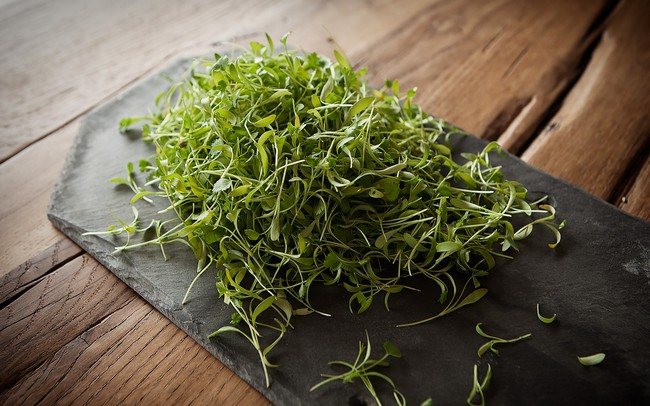

Growing at home
Grow microgreens at home began long before commercial production began. The technology for obtaining useful stems is simple, does not require costs, and is available to any housewife.
For growing on a windowsill, primitive equipment is suitable: a container with low sides. In addition, you will need a primer or a substitute. Farming does not use natural soil to avoid contamination or disease in the final product. At home, garden, flower soil is often used.
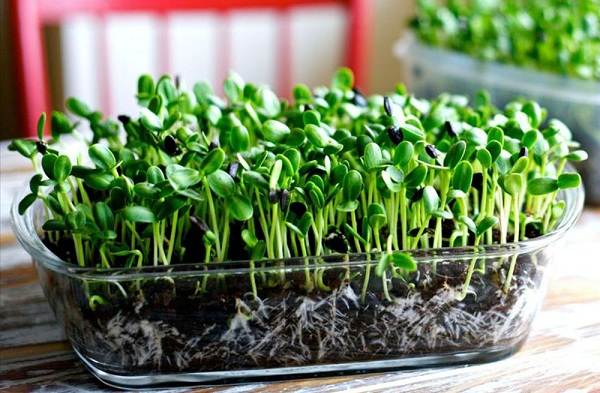

It is better to use coconut shavings instead of earth, special linen rugs, you can get by with several layers of gauze, even paper. Near the soil, when growing microgreens, there is a simple task: to retain water and plant roots.
It is easiest to master the cultivation of microgreens on simple, well-known seeds: peas, oats, dill. In the evening, the seeds are soaked. In the morning, the planting material can be considered prepared. Microgreen seeds evenly, in one layer, spread on a moistened substrate, cover the container with seeds, place in the dark.
The germination period does not last long - 1-2 days. The future microgreen is monitored: it should be wet, but not flooded. When most of the sprouts give roots, the container is exposed to light. The stage of active growth begins. After 2-4 days, cotyledons appear, after 5-10 days, real leaves. At the age of 1-2 weeks, the crop can be harvested.
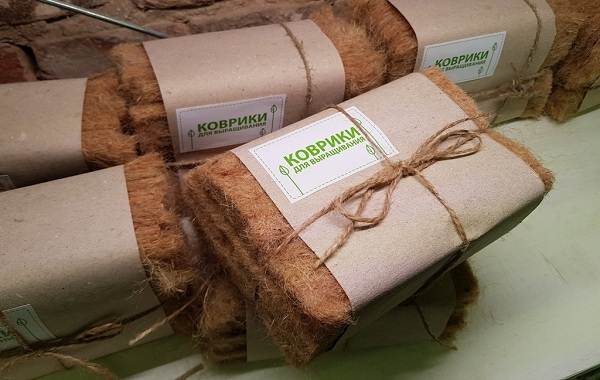

Germinating microgreens is easy and convenient in linen rugs
Industry produces germinator for microgreens... This device allows you to organize a semi-automatic farm for the production of vitamins on a windowsill in a city apartment.
The germinator is a container with a lid. Several trays with different types of greenery can be installed in it. At the bottom of each tray there is a grid-mat. Advanced models are equipped with a compressor to circulate the water. The running water provides the seeds with oxygen and prevents them from becoming moldy.
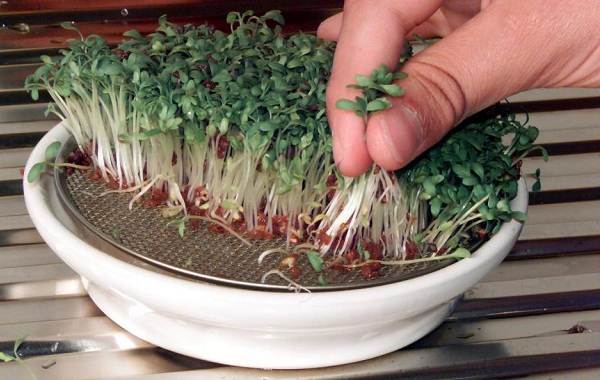

What are microgreens?
Microgreens are sprouts of vegetable and green crops used for food in the phase of 1-2 of a true leaf (usually at the age of no more than 10-14 days, for early ripening crops - for example, watercress - 4-6 days is enough). The maximum height of such plants is 4 cm; only peas and sunflowers can be higher.
It is easy to grow microgreens: you do not need large areas and special conditions, you do not need to wait long for the harvest and take care of its storage. Even a very busy city dweller can set up his own "green conveyor"; all that is required is a little space on the windowsill, seeds and containers with a suitable substrate.
If there are children in the family, be sure to involve them in “micro-township” - young naturalists will love it!
Microgreen seeds
Solanaceous seeds (eggplant, potatoes, peppers, tomatoes) are not suitable for growing microgreens. Their sprouts and unripe fruits contain a toxic substance: the alkaloid solanine. This alkaloid can be troublesome when consumed in large quantities.
To obtain a harvest, two types of seeds are used: ordinary, specialized. Seed material is an expensive product, you need a lot of it. One of the main quality indicators is germination. Sellers of specialized seeds focused on growing microgreens promise a germination rate of at least 95%.
High-quality planting material should not contain traces of chemical processing. Confidence in environmental friendliness must be complete. In addition to chemical inclusions of herbicides, pesticides, there should be no pathogenic bacteria, viruses, fungal spores. No place among the future harvest for alien seeds.
According to experienced farmers, these requirements are met by imported (European) products. Foreign seeds are more expensive, but the germination rate will be higher than 95%. Microgreens in the photo looks like a forest of twin sprouts of the same height and perfect appearance.
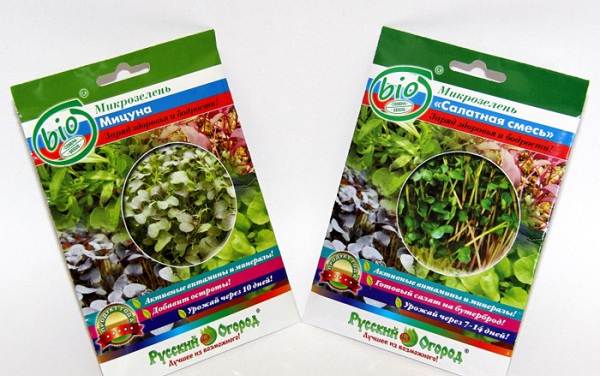

In shops you can buy assorted microgreen seeds or purchase regular crop seeds.
How to grow microgreens?
Ready to reap the many health benefits and versatility that microgreens have to offer?
Growing microgreens is easy and requires minimal experience, tools and equipment. If you're ready to get started, here's how to grow microgreen:
- If you are growing indoors, start by placing about 3 centimeters of soil in a shallow tray. For outdoor use, highlight and cleanse a small area of your garden.
- Then spread the seeds evenly over the soil. Keep in mind that because these plants will be harvested before they reach maturity, you may be able to place them closer together than if you grew them to their full size.
- Cover the seeds with soil and spray the top of the soil with water.
- If growing indoors, place a shallow tray by a window with natural light or special light. You can also use a warming mat to speed up plant growth, but this is not required.
- Spray water on the soil several times a day to help the plants germinate and stay hydrated.
- Once the microgreens are 3 or 9 centimeters tall, they can be harvested by pruning the greens above the soil line. This is usually 7 to 14 days after germination, although this can vary depending on the type of plant.
- When you're ready to plant another batch, either remove the roots or simply empty the tray completely and restart it with new soil.
Growing microgreens as a business idea
Growing microgreens Is a relatively new, rapidly developing direction in business, based on three pillars:
- More and more people, taking care of their health, include natural, fresh, organic food in their diet. The number of potential consumers of microgreens is growing.
- At the initial stage, the business of growing microgreens does not require significant material and human resources.
- The cultivation of microgreens can be carried out by schoolchildren, housewives, pensioners who do not have an agronomic education. The necessary knowledge how to grow microgreens, people who are not associated with gardening and plant growing quickly take over.
Entrepreneurs of any age, educational level, and financial situation can count on business success. The demand for microgreens is high in big cities, where healthy green sprouts are the easiest to sell.
Their cultivation is best located close to consumers, that is, in the city itself or in the nearest suburbs. In order for microgreens to bring not only vitamins, but also money, you need to take several steps.
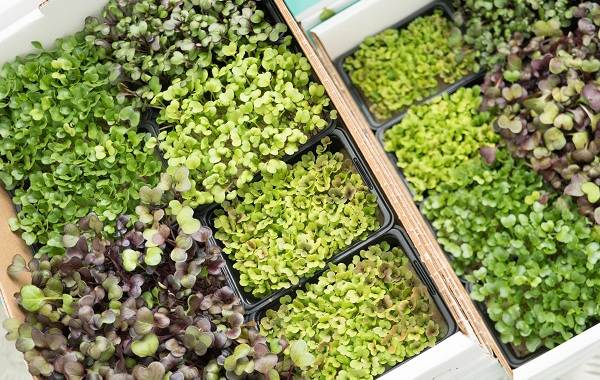

Analysis of the sales market and the level of competition
Business conditions are determined at the first stage. Specialized companies can carry out the work, this approach is costly. Self-analysis will contain fewer professional terms, but it will give an opportunity to feel the market, find out the availability of demand and the degree of its satisfaction.
A preliminary assessment can be made without leaving the table. With the help of the Internet, it is found out how often people are interested in microgreens, which online stores and sellers offer fresh seedlings in a given region.
Personal communication will help you find out if nearby cafes and restaurants are ready to introduce dishes with the addition of young shoots into their menus. Are there shops in the city for vegetarians and connoisseurs of natural food? Are they involved in the implementation of microgreening.
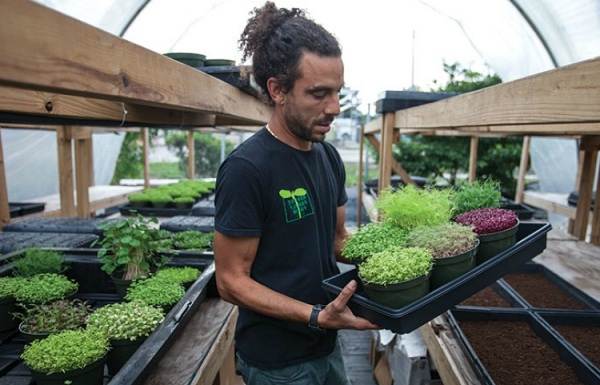

Premises for growing microgreens
The presence of a barn, garage, basement is a prerequisite for starting a business. The area of the room can be small. It is necessary to provide heating devices, illuminators and fans. At the initial stage, manual on / off and adjustment can be dispensed with. Automatic systems for maintaining climatic conditions will appear as production develops.
Division of the room into zones, installation of shelving
A commercial sprout from a seed is obtained in no more than 2 weeks. The first 1-2 days, the sown plants do not require lighting. Dividing the room into zones that can be lit or kept in the dark helps save energy.
Before purchasing racks and pallets, you have to make a choice: what type of soil to use. For growing microgreens, natural soil is suitable (professionals do not use it), coconut substrate, many prefer hydroponics. Different agrotechnical techniques entail the use of different pallets and the adaptation of racks to them.
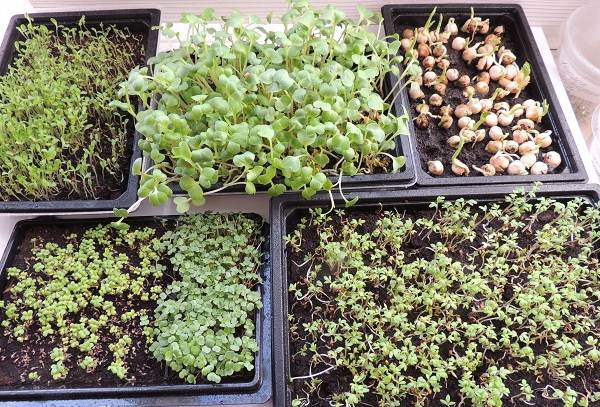

With the right approach, growing microgreens can be turned into a profitable business.
Purchase of seeds
Microgreens most often grow from ordinary seeds. In recent years, breeders have developed plants that produce special seeds. They have a high germination rate, they grow actively in the first two weeks of life. Microgreen seeds are more expensive.
In order not to be deceived, not to buy seeds with weak starting characteristics, they do it simply. Suppliers are checked by trial and error: small, trial lots of seeds are sown.
Growing microgreens
Before starting germination, the seeds are soaked. Future sprouts saturated with moisture are laid out for 1-3 days on baking sheets. In the dark and warm, they should sprout. Sprouted seeds are transferred to trays with a substrate.
When growing greenery for sale, land or sand is rarely used. Particles of such soil can contaminate the sprouts, which is unacceptable. The most commonly used coconut flakes, linen rugs, vermiculite granules, mineral wool. After 7-14 days, the harvest is ready.
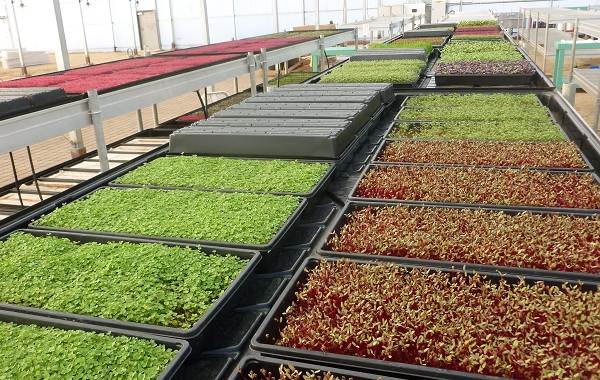

Business documentation, product certification
Bureaucratic barriers are not very high; overcoming them takes time and financial costs. First of all, the entrepreneur registers an LLC or individual entrepreneur. Then comes the stage of developing technical specifications. They specify the characteristics of the product (microgreens) and the conditions for its cultivation.
At the final step, a declaration of conformity with the technical regulations of the Customs Union is drawn up, and HACCP is being developed. In order to become the owner of these documents, to distribute microgreens legally, it is better to contact a company that solves these issues on a turnkey basis.
Financial aspects
The initial investment for the creation of a farm for growing microgreens, which can be served by 1 person, will amount to the equivalent of 5-7 thousand dollars. Costs depend on the region, the city in which the farm is organized, and the entrepreneurial entrepreneurial spirit.
The money will be spent on renting premises, purchasing and installing racks, heating and lighting equipment, buying a monthly supply of seeds, substrate, paying for electricity and water. The same amount includes the costs of registration of the enterprise and certification of products.
In the process of work, there will be spending on utilities, taxes, transport. Don't forget about advertising. In this matter, help will be provided by the Internet, advertising brochures and entrepreneurial initiative.
Microgreens as a business has a significant plus - the first results appear 2 weeks after the start of the operation of the farm. A farmer can sell 100 g of greens to a restaurateur or merchant for 20–100 rubles. The retail price of microgreen is several times higher. One 4-tier rack can produce up to 100 kg of greens per month.A farm consisting of 4-6 racks will pay off in a year.
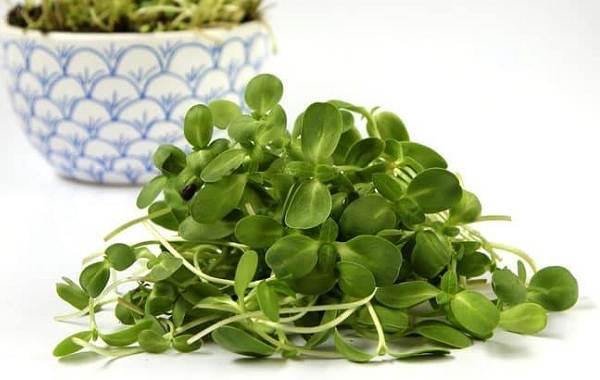

How to grow microgreens without soil
Agree that it is not very convenient to store land in large quantities in an urban environment. Therefore, we advise using linen or jute burlap for growing microgreens, as it is an environmentally friendly material.
Unfortunately, it is not easy to find it on sale. The most readily available substrates are medical gauze and organic cotton wool, which can be purchased at specialty health stores and pharmacies.
- Soak the required amount of seeds in water overnight.
- Then rinse them thoroughly. This must be done so that mold does not form in the future.
- Cut a piece of cheesecloth (sized to fit your germination mold). It takes about 5-6 layers so that moisture is well absorbed and there is no sudden drying.
- Place cheesecloth at the bottom of the container, and soaked seeds on top of it. Spread them evenly over the surface so that all seeds receive oxygen, are well ventilated, and mold does not form.
- After that, sprinkle them generously with water, but avoid the appearance of the "swamp".
- If you plan to use several containers of the same size at the same time, then stack them on top of each other. Pull cling film on the last tray and be sure to make 2-3 holes in it. This is necessary in order to create a greenhouse effect to retain moisture and air ingress. You can use a plate or tray instead of film. Since they are not tightly adjacent, oxygen will enter the interior of the tray. Leave the resulting structure for about 1 day, periodically look after your "harvest".
- As soon as you notice the first sprouts, then place the trays separately from each other in a lighted place. Do not forget to periodically spray them with water, do not allow the substrate to dry out. Microgreens like a humid and ventilated room, t = 18-20 ° C.
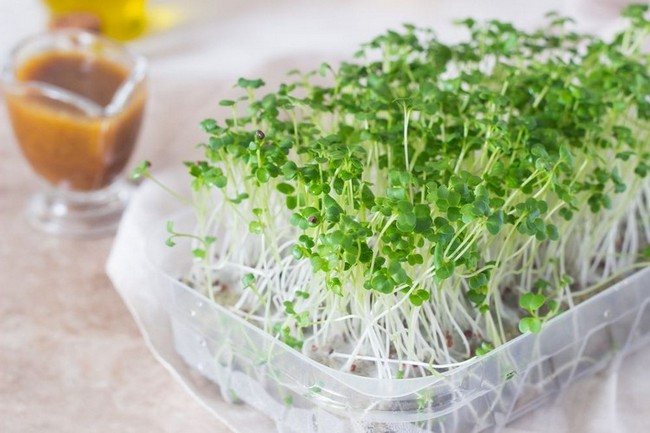

Garden, vegetable garden and flower garden tips
Plant transplantation according to the lunar calendar May 2019
Planting days in May 2020 in Siberia
What flowers can be planted in May by seeds
Price
Fresh microgreens are purchased in grocery supermarkets or in stores focused on selling natural, organic products. All types of microgreens are offered in online stores. Popular purple basil in sprouts will cost 180 rubles. for a 20-gram package. Yellow peas are cheaper. They ask for 80 rubles. for 20 g.
It is easy to find and purchase seeds for growing microgreens on the Internet. For a 100-gram package of broccoli seeds, you will have to pay about 400 rubles. Small mustard seeds are cheap: about 90 rubles. for 100 g.
In addition to seeds, online stores offer equipment, germinators for microgreens
, substrates necessary for growing microgreen on a windowsill or on your own farm.

